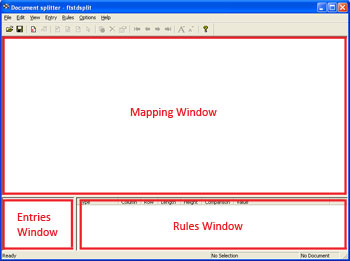Overview
The main purpose of FTSplit is to provide and implement rules for identifying data as it is received by FTSpooler. Once identified, data can be associated with a specific form or may be redirected to another queue for further processing, typically to be formatted using a different form. Such a need is common in two situations:
- where FormTrap is being used to process a large number of varied documents, which would otherwise require the creation of multiple FTSpooler queues; and
- where the file needs splitting into individual documents that require individual delivery (email or fax).
Splitting involves two components: FTSplitDef is the design environment that allows you to create rules for identifying and splitting batch runs; and FTSplit is the run time component used by the FormTrap Spooler. FTSplit allows you to identify data, split that data into separate documents according to your user-defined rules as well as removing unwanted pages of data such as summary details from the file.
FTSplit
FTSplit operates according to three sets of rules. For each type of data file you need to define:
- Identification rules - which identify the Entire File as one type of document.
- Unwanted page rules (optional) - which identify pages in the data stream that you do not want to process.
- Split rules (optional) - which identify information that is used to split the data file into individual documents (e.g. change in document number or page one).
When FTSplit receives a file, it performs the following functions:
- FTSplit analyses the data file to determine the type of document it is working with. This is done for the first three pages only, if the first of multiple entries does not succeed it looks at the second and so on.
- If the identified document has any unwanted page rules, FTSplit removes all pages from the data that match these rules before continuing.
- If the document type has rules for splitting, then FTSplit begins writing data to file until the first split rule succeeds. The file is then closed and FTSplit begins writing a new file until the split rule again succeeds. It does this until all documents in a batch run have been re-written to separate files according to the rules for splitting.
Note: Trying to split a SINGLE INPUT FILE into two or more alternate outputs CANNOT BE DONE. Each file is recognized ONCE ONLY, against ONE ONLY of the entries.
See here for emailing (or faxing) individual documents.
FTSplitDef
Using FTSplitDef, you load a sample data file and create the rules to identify the data, remove unwanted pages and split the data file into individual documents. This information is saved into a rule file for use with FTSplit.
- Entries Window - contains a list of the defined entries.
- Mapping Window - displays the sample data file, onto which you can map the rules.
- Rules Window - displays the rules you have created for the selected entry.



